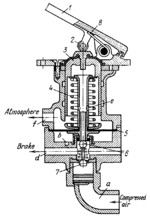
 Click to enlarge Click to enlarge
|
Description
When brake pedal 1 is depressed, roller 2 depresses plunger 3, compressing spring 4. The force of spring 4 bends membrane 5 downward. This closes discharge valve 6 (which is not completely closed in the initial position of the membrane) and opens input valve 7. Compressed air from the tank is admitted through passage a and is delivered to the brake cylinders through passage d, producing the braking action. At the same time, pressure in passage d is transmitted through orifice b into the space under membrane 5. If pedal 1 is held in the deprassed position, membrane 5 takes up a position in which both valves are closed and the pressure in the brake cylinders is constant. When released, pedal 1 is returned to its initial position by spring 8, and plunger 3, by spring 4. At this, membrane 5 is bent upward, opening discharge valve 6 and closing input valve 7. Air from the brake cylinders is discharged to the atmosphere through passage e in the stem of the membrane and port f. This releases the brakes.
$4044$EHP,Va$
|

 Click to enlarge
Click to enlarge






